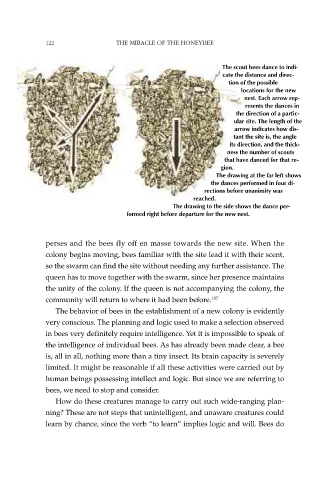Page 124 - The Miracle of the Honeybee
P. 124
122 THE MIRACLE OF THE HONEYBEE
The scout bees dance to indi-
cate the distance and direc-
tion of the possible
locations for the new
nest. Each arrow rep-
resents the dances in
the direction of a partic-
ular site. The length of the
arrow indicates how dis-
tant the site is, the angle
its direction, and the thick-
ness the number of scouts
that have danced for that re-
gion.
The drawing at the far left shows
the dances performed in four di-
rections before unanimity was
reached.
The drawing to the side shows the dance per-
formed right before departure for the new nest.
perses and the bees fly off en masse towards the new site. When the
colony begins moving, bees familiar with the site lead it with their scent,
so the swarm can find the site without needing any further assistance. The
queen has to move together with the swarm, since her presence maintains
the unity of the colony. If the queen is not accompanying the colony, the
community will return to where it had been before. 107
The behavior of bees in the establishment of a new colony is evidently
very conscious. The planning and logic used to make a selection observed
in bees very definitely require intelligence. Yet it is impossible to speak of
the intelligence of individual bees. As has already been made clear, a bee
is, all in all, nothing more than a tiny insect. Its brain capacity is severely
limited. It might be reasonable if all these activities were carried out by
human beings possessing intellect and logic. But since we are referring to
bees, we need to stop and consider.
How do these creatures manage to carry out such wide-ranging plan-
ning? These are not steps that unintelligent, and unaware creatures could
learn by chance, since the verb “to learn” implies logic and will. Bees do

